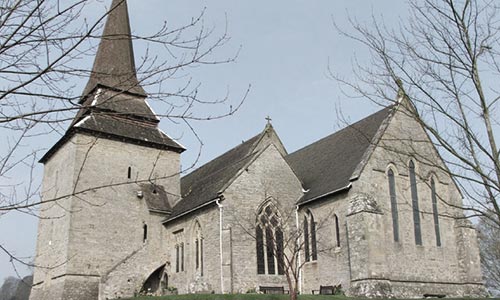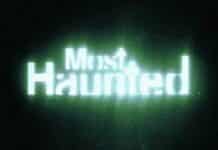POLLYANNA JONES says a tomb in Kington, Herefordshire, contains untold evil known as the Black Vaughan…
Kington is a Herefordshire town, found on the border of England and Wales. As you enter St Mary’s church, to your right can be found an exquisite alabaster tomb, in which Ellen and Thomas Vaughan’s bodies are laid to rest.
Thomas was a 15th century lord, who fought on the Yorkist side during the War of the Roses. He was slain at the Battle of Banbury in 1469, and it was said that his headless body was returned to Kington where he was buried.
But death brought no rest for Thomas. Legend tells us that his spirit lingered on and terrorised the townsfolk. Thomas Vaughan became known as “Black Vaughan”, and stories grew of his wicked and evil reputation in life that continued beyond the grave. This folktale describes how at last, the clergy made attempts to be rid of him once and for all.

Once at Kington in Herefordshire there roamed a wicked spirit known as Black Vaughan who at best was to be described as a nuisance. Worse, he was a terror, and would cause fright and alarm for everyone in Kington. This malevolent spirit took great pleasure in upsetting travellers and their animals. After nightfall he would hide behind hedges, then appear suddenly in a rush in the road to spook horses, or tip wagons loaded with goods. He would send the cattle stampeding into the river, and tip up churns in the dairy, leaving nothing for the farmer in the morning. It was as if he wanted to see the town brought to ruin, and it was working. After a time, people were too scared of Black Vaughan to come to Kington to market. Trade dwindled, and the people were afraid that the market would have to be closed.
For a small rural community, such a situation was disastrous, and after Black Vaughan charged into St. Mary’s church in the form of a large Hereford bull, the villagers decided that enough was enough.
A small group of farmers travelled into Wales to seek out a wise man that dwelt in the mountains. After hearing of what they were suffering, the old and weathered man exclaimed, “Ah, this be a wicked spirit, and you will get no peace from him ‘til you lay him.”
The wise man then described the method that must be used in the ritual to lay the ghost:
“It isn’t easy. But you must get twelve parsons, good ones and stout-hearted ones, and let them take with them a woman and an innocent baby, and let them read him down. He’s a big spirit now, and I can see that he’s getting bigger; but if you read to him from the Bible and pray steadily against him you’ll read him down. No use dropping the book as your parson did the other day, and getting under the chair or bed. You must keep at him, and then you’ll read him down and down and down ‘til you can get him into a snuffbox. Then catch hold of him and you’ll be able to bury him like a mouse.”
The men returned to Kington with their news, and one autumn night, twelve parsons gathered with a candle at the church. Lighting their candles, they stood dressed in their white surplices in a wide ring in the centre of the church. A small silver snuff box was placed directly in the centre. On the outside of the ring was a woman with an infant baby, born only the day before. Many curious townsfolk also were gathered, to see what would come to pass. The quiet was broken only by the burbling coos of the child, and then with candles in left hand, and Bibles in right, the parsons began.
Psalms were sang, and then the parsons held their candles up as the oldest of them called out in a loud voice, “Are you there, Black Vaughan?” No reply was heard, but a tenseness grew among the townsfolk as outside the wind began to blow up a gale.
The parsons chanted together, and suddenly something was heard to move through the air above the circle. A candle was extinguished, and with a gasp, the parson holding it dropped it to the floor, before falling to his knees in fear and letting his bible fall.
The crowd gasped, and the baby began to cry. From the darkness above in the church roof was heard a callous and triumphant laugh. A second candle went out, then a third and fourth, as the townsfolk began to panic and pray. The baby’s cries were shushed by his worried mother, but no calm would come. Evil was in this sacred place, laughing at them and toying with their fear.
Some of the crowd began to rush for the church doors, but seeing this the oldest parson cried out, “No! Never give up! Don’t be afraid! Listen to him! We’ve made him come back to us – and he’s growing smaller and smaller. Have courage and faith, good friends and we’ll read him down yet.”
At these words, the townsfolk warily turned back, ashamed that they had feared this spirit was more mighty than God himself in his own house. Black Vaughan was angered, and swooped down upon the circle. Out went a fifth, sixth, then seventh candle. As the church grew darker, the people fell into a frightened silence. Even the baby stopped crying.
But it seemed the older parson was right. When the evil spirit’s triumphant laugh was next heard, it sounded more like that of a boy than a man, and the townsfolk began to find their courage again. As did the parsons, who read on as the eighth and ninth candles were extinguished. The ritual was working.
The townsfolk cheered the oldest parson on, as he read how devils were cast out of a madman by Jesus who compelled them to enter into swine. At this point, they heard the sound of something bumping against the glass windows and roof, as if a bird was trapped inside and was trying to find a way out.
Black Vaughan was weakening, and was trying to flee. The parson would not stop, instead as the tenth, and eleventh candle went out, he threw away his Bible, and shielding his candle with his right hand, prayed for the spirit to be conquered. His flame grew brighter and brighter, until it gave as much light as the twelve candles all together had, and then there was the sound of something small thudding onto the floor into the centre of the circle.
The parson cried out, “In the name of the Father, Son and Holy Ghost, I command thee, Black Vaughan, into the box that lieth there on the floor.”
All were silent, and heard the sound of tiny footsteps were heard going across the floor. The parson asked, “Black Vaughan, Black Vaughan, where wilt thou be laid?” He paused and the congregation listened with all its ears, and a tiny voice replied, “Anywhere, anywhere, but not in the Red Sea.”
“He’s in the box.” Cried the parson victoriously. The church was filled with cheers as the snuffbox was bound with twine, then sealed in an iron casket. By torchlight, the parson led his fellows and the townsfolk to a nearby pond and threw Black Vaughan in.
At the bottom of the murky water, he remains to this day. Angrier than ever, always seeking a way to escape. Should you find a casket in a pool in Kington, leave it well alone, lest you unleash something evil…







Very interesting article.